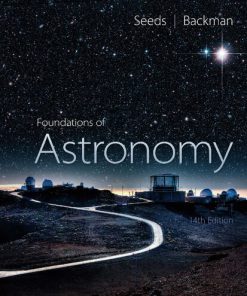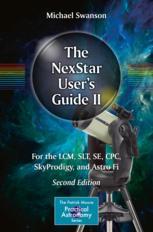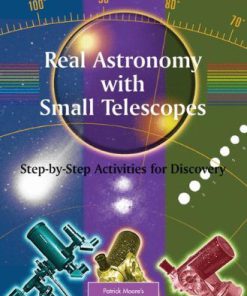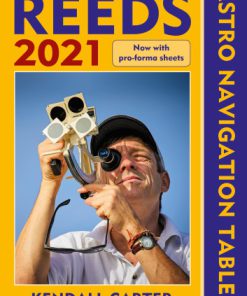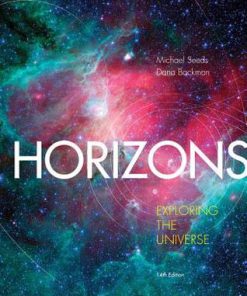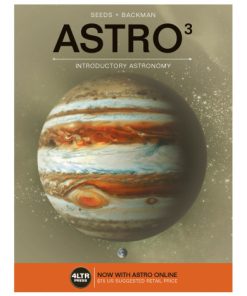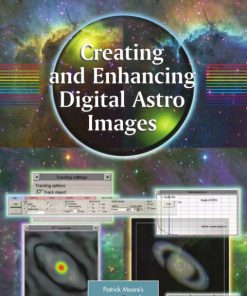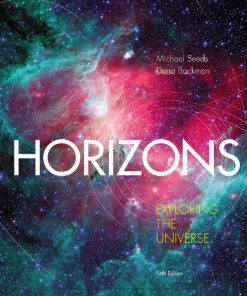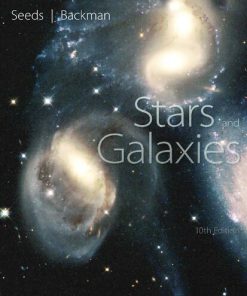ASTRO 3 Introductory Astronomy 1st edition by Michael Seeds, Dana Backman 8214337821 9798214337821
$50.00 Original price was: $50.00.$25.00Current price is: $25.00.
ASTRO 3: Introductory Astronomy 1st edition by Michael A. Seeds, Dana Backman – Ebook PDF Instant Download/DeliveryISBN: 8214337821, 9798214337821
Full download ASTRO 3: Introductory Astronomy 1st edition after payment.
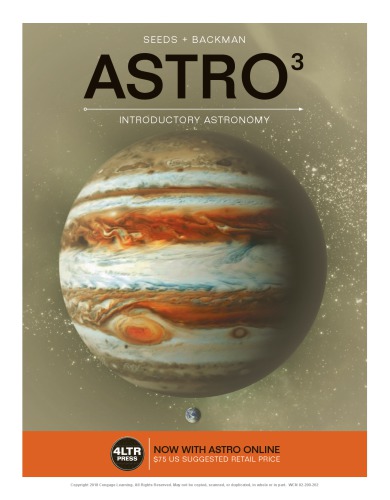
Product details:
ISBN-10 : 8214337821
ISBN-13 : 9798214337821
Author: Michael A. Seeds, Dana Backman
Based on cutting-edge research of student study preferences and workflows, ASTRO 3 equips you with your ideal combination of print and digital resources to help you maximize your course success. An easy-reference, paperback textbook presents course content through visually engaging chapters while convenient tear-out Chapter Review Cards consolidate key concepts into a ready-made study tool.
ASTRO 3: Introductory Astronomy 1st table of contents:
Chapter 1. Here and Now
1-1. Where Is Here?
1-2. When Is Now?
. Topic Summaries/Key Terms
Questions and Problems
Chapter 2. User’s Guide to the Sky: Patterns and Cycles
2-1. The Stars
2-1a. Constellations
2-1b. Star Names
2-1c. Star Brightness
2-2. The Sky and Its Motions
2-2a. The Celestial Sphere
2-2b. Precession
2-3. The Cycle of the Sun
2-3a. Apparent Annual Motion of the Sun
2-3b. Seasons
2-4. Cycles of the Moon
2-4a. Motion of the Moon
2-4b. The Cycle of Moon Phases
2-4c. Solar Eclipses
2-4d. Lunar Eclipses
. Topic Summaries/Key Terms
Questions and Problems
Chapter 3. The Origin of Modern Astronomy
3-1. Astronomy Before Copernicus
3-1a. Aristotle’s Universe
3-2. Nicolaus Copernicus
3-2a. Copernicus’s Model
3-2b. De Revolutionibus
3-3. Tycho Brahe, Johannes Kepler, and Planetary Motion
3-3a. Tycho Brahe
3-3b. Johannes Kepler
3-3c. Kepler’s Three Laws of Planetary Motion
3-4. Galileo Galilei
3-4a. Telescopic Observations
3-4b. Dialogo and Trial
3-4c. Two Ways to Understand the World
3-5. Isaac Newton, Gravity, and Orbits
3-5a. Isaac Newton
3-5b. Orbital Motion
3-5c. Tides: Gravity in Action
3-5d. Newton’s Universe
. Topic Summaries/Key Terms
Questions and Problems
Chapter 4. Light and Telescopes
4-1. Radiation: Information from Space
4-1a. Light as Waves and Particles
4-1b. The Electromagnetic Spectrum
4-2. Telescopes
4-2a. Two Kinds of Telescopes
4-2b. The Powers of a Telescope
4-3. Observatories on Earth—Optical and Radio
4-4. Astronomical Instruments and Techniques
4-4a. Imaging Systems and Photometers
4-4b. Spectrographs
4-5. Airborne and Space Observatories
4-5a. The Ends of the Visual Spectrum
4-5b. Telescopes in Space
. Topic Summaries/Key Terms
Questions and Problems
Chapter 5. Sun Light and Sun Atoms
5-1. The Sun: Basic Characteristics
5-1a. Distance and Size
5-1b. Mass and Density
5-2. The Origin of Sunlight
5-2a. Atoms and Subatomic Particles
5-2b. Temperature, Heat, and Blackbody Radiation
5-3. The Sun’s Surface
5-3a. The Photosphere
5-3b. Heat Flow in the Sun
5-4. Light, Matter, and Motion
5-4a. Electron Shells
5-4b. The Excitation of Atoms
5-4c. Measuring Velocities: The Doppler Effect
5-5. The Sun’s Atmosphere
5-5a. Formation of Spectra
5-5b. The Sun’s Chemical Composition
5-5c. The Chromosphere
5-5d. The Corona
5-6. Solar Activity
5-6a. Observing the Sun
5-6b. Sunspots
5-6c. Insight into the Sun’s Interior
5-6d. The Sun’s Magnetic Cycle
5-6e. The Babcock Model for Solar Activity
5-6f. Chromospheric and Coronal Activity
. Topic Summaries/Key Terms
Questions and Problems
Chapter 6. The Terrestrial Planets
6-1. A Travel Guide to the Terrestrial Planets
6-1a. The Scale of the Solar System
6-1b. Revolution and Rotation
6-1c. Two Kinds of Planets
6-1d. Core, Mantle, and Crust
6-1e. Atmospheres
6-2. Earth: The Active Planet
6-2a. Earth’s Interior
6-2b. Earth’s Active Crust
6-2c. Earth’s Atmosphere
6-2d. Oxygen in Earth’s Atmosphere
6-2e. A Short Geological History of Earth
6-3. The Moon
6-3a. Lunar Geology
6-3b. The Origin of Earth’s Moon
6-3c. A History of Earth’s Moon
6-4. Mercury
6-4a. Spacecraft at Mercury
6-4b. A History of Mercury
6-5. Venus
6-5a. Venus’s Atmosphere
6-5b. Venus’s Surface
6-5c. A History of Venus
6-6. Mars
6-6a. Mars’s Atmosphere
6-6b. Exploring Mars’s Surface
6-6c. Finding the Water on Mars
6-6d. A History of Mars
6-6e. Mars’s Moons
. Topic Summaries/Key Terms
Questions and Problems
Chapter 7. The Outer Solar System
7-1. A Travel Guide to the Outer Solar System
7-1a. Planets and Dwarf Planets
7-1b. Atmospheres and Interiors
7-1c. Satellite Systems
7-2. Jupiter
7-2a. Jupiter’s Interior
7-2b. Jupiter’s Complex Atmosphere
7-2c. Jupiter’s Rings
7-2d. Jupiter’s Family of Moons
7-2e. A History of Jupiter
7-3. Saturn
7-3a. Planet Saturn
7-3b. Saturn’s Rings
7-3c. Saturn’s Family of Moons
7-4. Uranus
7-4a. Planet Uranus
7-4b. Uranus’s Moons
7-4c. Uranus’s Rings
7-5. Neptune
7-5a. Planet Neptune
7-5b. Neptune’s Moons
7-5c. Neptune’s Rings
7-6. Pluto: Planet No More
7-6a. What Defines a Planet?
7-6b. Pluto and the Plutinos
. Topic Summaries/Key Terms
Questions and Problems
Chapter 8. Origin of the Solar System and Extrasolar Planets
8-1. Solar System Overview
8-1a. Size and Shape
8-1b. Terrestrial and Jovian Planets
8-2. Space Debris: Asteroids, Comets, and Meteorites
8-2a. Asteroids
8-2b. Comets
8-2c. Meteors, Meteoroids, Meteorites
8-3. The Origin of the Solar System
8-3a. The Age of the Solar System
8-3b. The Solar Nebula Theory
8-3c. Chemical Composition of the Solar Nebula
8-3d. Condensation of Solids
8-3e. Accretion of Planetesimals
8-4. The Story of Planet Building
8-4a. Growth of Protoplanets
8-4b. Bombardment of the Planets
8-4c. The Jovian Problem
8-4d. Explaining the Characteristics of the Solar System
8-4e. The History of the Atoms in Your Body
8-5. Planets Around Other Stars
8-5a. Debris Disks
8-5b. Extrasolar Planets
. Topic Summaries/Key Terms
Questions and Problems
Chapter 9. The Family of Stars
9-1. Star Distances
9-1a. The Surveyor’s Triangulation Method
9-1b. The Astronomer’s Triangulation Method
9-2. Apparent Brightness, Intrinsic Brightness, and Luminosity
9-2a. Brightness and Distance
9-2b. Absolute Visual Magnitude
9-2c. Luminosity
9-3. Star Temperatures
9-3a. Temperature Spectral Types
9-4. Star Sizes
9-4a. Luminosity, Temperature, and Radius
9-4b. Luminosity Spectral Classification
9-5. Star Masses—Binary Stars
9-5a. Binary Star Orbits
9-5b. Three Kinds of Binary Systems
9-6. Typical Stars
9-6a. Mass, Luminosity, and Density
9-6b. Surveying the Stars
. Topic Summaries/Key Terms
Questions and Problems
Chapter 10. Structure and Formation of Stars
10-1. Stellar Structure
10-1a. The Laws of Conservation of Mass and Energy
10-1b. Hydrostatic Equilibrium
10-1c. Energy Transport
10-1d. Stellar Models
10-2. Nuclear Fusion in the Sun and Stars
10-2a. Nuclear Binding Energy
10-2b. Hydrogen Fusion
10-2c. Neutrinos from the Sun’s Core
10-2d. The Pressure–Temperature Thermostat
10-3. Main-Sequence Stars
10-3a. The Mass–Luminosity Relation
10-3b. Brown Dwarfs
10-3c. Lives of Main-Sequence Stars
10-4. The Birth of Stars
10-4a. The Interstellar Medium
10-4b. Formation of Stars from the Interstellar Medium
10-4c. Formation of Protostars
10-4d. Observations of Star Formation
10-4e. The Orion Nebula
10-4f. Evidence of Young Stars
. Topic Summaries/Key Terms
Questions and Problems
Chapter 11. The Deaths of Stars
11-1. Giant Stars
11-1a. Expansion into a Giant
11-1b. Helium Fusion
11-1c. Star Clusters: Evidence of Evolution
11-2. Deaths of Low-Mass Stars
11-2a. Red Dwarfs
11-2b. Medium-Mass (Sunlike) Stars
11-2c. Planetary Nebulae
11-2d. White Dwarfs
11-2e. The Fate of the Sun and the End of Earth
11-3. The Evolution of Binary Systems
11-3a. Mass Transfer and Accretion Disks
11-3b. Novae
11-4. The Deaths of Massive Stars
11-4a. Nuclear Fusion in Massive Stars
11-4b. Supernova Explosions
11-4c. Types of Supernovae
11-4d. Observations of Supernovae
11-5. Neutron Stars
11-5a. Theoretical Prediction of Neutron Stars
11-5b. The Discovery of Pulsars
11-5c. The Evolution of Pulsars
11-5d. Binary Pulsars
11-5e. The Fastest Pulsars
11-5f. Pulsar Planets
11-6. Black Holes
11-6a. Escape Velocity
11-6b. Schwarzschild Black Holes
11-6c. Leaping into a Black Hole
11-6d. The Search for Black Holes
11-6e. Energy from Compact Objects—Jets
11-6f. Energy from Compact Objects—Gamma-Ray Bursts
. Topic Summaries/Key Terms
Questions and Problems
Chapter 12. The Milky Way Galaxy
12-1. Discovery of the Galaxy
12-1a. The Great Star System
12-1b. Size of the Milky Way
12-1c. Star Clusters and the Center of the Galaxy
12-1d. Components of the Galaxy
12-1e. Mass of the Galaxy
12-2. Spiral Arms and Star Formation
12-2a. Tracing the Spiral Arms
12-2b. Star Formation in Spiral Arms
12-3. Origin and History of the Galaxy
12-3a. Age of the Galaxy
12-3b. Stellar Populations
12-3c. The Element-Building Cycle
12-3d. History of the Galaxy
12-4. The Nucleus of the Galaxy
12-4a. Observations of the Nucleus
. Topic Summaries/Key Terms
Questions and Problems
Chapter 13. Galaxies: Normal and Active
13-1. The Family of Galaxies
13-2. Measuring the Properties of Galaxies
13-2a. Distance
13-2b. Telescopes as Time Machines
13-2c. The Hubble Law
13-2d. Galaxy Diameters and Luminosities
13-2e. Galaxy Masses
13-2f. Dark Matter in Galaxies
13-2g. Supermassive Black Holes in Galaxies
13-3. The Evolution of Galaxies
13-3a. Clusters of Galaxies
13-3b. Colliding Galaxies
13-3c. Origin and Evolution of Galaxies
13-4. Active Galaxies and Quasars
13-4a. Seyfert Galaxies
13-4b. Double-Lobed Radio Sources
13-4c. Quasars
13-4d. A Unified Model of Active Galaxies
13-4e. The Origin of Supermassive Black Holes
13-4f. Quasars Through Time
. Topic Summaries/Key Terms
Questions and Problems
Chapter 14. Modern Cosmology
14-1. Introduction to the Universe
14-1a. The Edge–Center Problem
14-1b. The Idea of a Beginning
14-1c. Cosmic Expansion
14-2. The Big Bang
14-2a. Imagining the Big Bang
14-2b. Evidence for the Big Bang—The Cosmic Microwave Background
14-2c. Particles and Nucleosynthesis—The First Seconds and Minutes
14-2d. Recombination and Reionization—The First Thousands and Millions of Years
14-3. Space and Time, Matter and Energy
14-3a. Looking at the Universe
14-3b. Cosmic Redshifts
14-3c. Model Universes
14-3d. Ordinary Matter and Dark Matter
14-4. Twenty-First-Century Cosmology
14-4a. Inflation
14-4b. Acceleration of the Expansion
14-4c. Dark Energy and Acceleration
14-4d. The Universe’s Future
14-4e. Origin of Structure
14-4f. Curvature of Space-Time
. Topic Summaries/Key Terms
Questions and Problems
Chapter 15. Life on Other Worlds
15-1. The Nature of Life
15-1a. The Physical Basis of Life
15-1b. Information Storage and Duplication
15-1c. Modifying the Information
15-2. Life in the Universe
15-2a. Origin of Life on Earth
15-2b. Deep Time and the Evolution of Life
15-2c. Life in Our Solar System
15-2d. Life in Other Planetary Systems
15-3. Intelligent Life in the Universe
15-3a. Travel Between the Stars
15-3b. Radio Communication
15-3c. How Many Inhabited Worlds?
People also search for ASTRO 3: Introductory Astronomy 1st:
lecture-tutorials for introductory astronomy 3rd edition answers pdf
lecture-tutorials for introductory astronomy 3rd edition answer key pdf
lecture-tutorials for introductory astronomy 3rd edition pdf
lecture-tutorials for introductory astronomy 3rd edition pdf free
lecture-tutorials for introductory astronomy 3rd edition answer key
Tags: ASTRO, Introductory Astronomy, Michael Seeds, Dana Backman
You may also like…
Science (General)
Reference - Atlases & Maps
Astronomy - The Universe - Astonomical Studies & Observations
Astronomy
ASTRO 3 Introductory Astronomy 1st edition by Michael Seeds, Dana Backman 8214337821 9798214337821
Science (General)
Astronomy - The Universe - Astonomical Studies & Observations
Horizons : Exploring the Universe Fourteenth Edition Michael A. Seeds
Astronomy - Stars - Astronomical Studies & Observations




